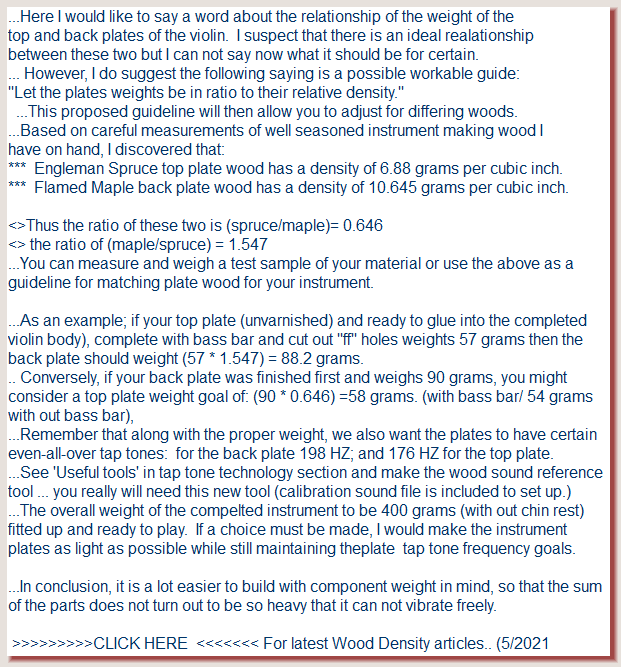Densities of instrument making woods.
...Some one asked me a question about wood density and so I have measured these samples of instrument making wood that I have at hand:
Type of Wood : Density in Grams per cubic inch:
Michigan, 'Birds Eye' Maple 18.74 Grams/ cubic inch
slab cut/ Kiln dried.
French Maple Slab cut 9.45 Grams/ cubic inch
(two samples).. 9.72 Grams/ cubic inch
French Maple, Quarter sawn 11.36 Grams/ cubic inch
Michigan Maple, slab cut 10.70 Grams/ cubic inch
[100 years under water]
Romanian Maple Neck blocks
[two samples] Medium flamed 8.95 Grams/ cubic inch
Highly flamed 10.00 Grams/ cubic inch
Bosnian Maple slab cut 10.11 Grams/ cubic inch.
[medium flame]
___________________________________________________________
Romanian Spruce 7.89 Grams/ cubic inch
Engleman Spruce, quarter sawn
Sample one ~150 year tree 6.59 Grams/ cubic inch
Sample two ~ 230 year tree 6.24 Grams/ cubic inch.
____________________________________________________________
Mount St. Helens "Spruce", two examples:
Sample one, wide grain (7.1 grains/ inch) 8.24 Grams/ cubic inch
Sample two, narrow grain (18.9 grains/ inch) 8.29 Grams/ cubic inch {184 year old]
____________________________________________________________
Douglas Fir (2 X 4 studs), two examples:
Sample one, (4.7 grains/ inch) 7.63 Grams/ cubic inch
Sample two, (7.3 grains/inch) 8.93 Grams/ cubic inch
____________________________________________________________
(Updated 5/2021)
Page V_39

...Simon Chambers (www.simonchamberstonewood.com) has posted a survey
of 'ideal' tone wood relative densities (specific gravity)(compared to water), which seems a good guide for instrument makers intent on making an excellent instrument.
He suggests a range of 0.32 to 0.36 densities (as compared to water) for spruce top plates. Other iinformation he has, gives an acceptable ideal range of 0.34 to 0.40.
For maple wood for back and neck, he suggests a range of 0.53 to 0.60.
These average out to 0.37 for spruce wood and 0.565 for maple wood.
These are compared to water, which weights 62.4 pounds per cubic foot; or 16.394 grams per cubic inch.
Thus spruce wood we use should be from 5.24 to 6.56 grams per cubic inch.
and the maple wood we use from between 8.69 to 9.84 grams per cubic inch.
Some conversion units:
454 grams per pound weight
water weights 62.4 pounds per cubic foot
1728 cubic inches / cubic foot
specific gravity is ratio of wood density compared to water density.
less than 1.0 floats and greater than 1.0 sinks in water.
Now let us say we know out wood is a bit on the dense side; we wonder how much we should reduce the graduation diminsions given for our plans to compensate for the differing wood density and wood stiffness?
As a rough guide, may I suggest the following method.
{for out rough calculation, I will assume that the stiffness is directly proportional to density increase and that stiffness increases by the square of the thichness increase.
So, for example, if our top wood has a specific gravity of 0.42 by measure and weighing and our goal average is 0.37; we know the density is: (0.42/0.37 = 1.135) or 13.5% too dense. Thus we need to make the graduation thickness smaller to compensate. I am assuming that this means the stiffness will also be 13.5 percent too much.
Since the wood stiffness goes by by the square (twice as thick is 4 times as stiff); what fraction times itself equaly 0.135? 3.68 comes out by experimenting with the calculator. So is I make the graduation depths; (1-{0.0368) times the pattern IE:0.9632 times X.
So if the pattern says 5mm I will leave 5 mm X 0.9632 = 4.82 mm instead.
This should give us close to the correct acoustical properties of our completed violin.
Of course, check plate weight to above chart and also get the tuned frequencies to 213 HZ for top plate and 242 HZ for back plate as a priority.
Good building....


